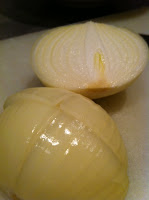I den gamle boken "Recipes of all nations" av Countess Morphy er det samlet oppskrifter fra 19 land, hvorav Norge faktisk er representert. Vårt kjære fedreland er dermed i godt selskap med stolte matnasjoner som Frankrike, Italia, Kina, Japan, Belgia og India, samt noen land som i hvert fall ikke i mitt hode er mest kjent for sin gastronomi (Russland og Polen). Hadde ikke trodd at Norge sto på matkartet på den tiden, men grevinnen syntes tydeligvis det var noe å skrive hjem om. Et raskt google-søk viser at boken var meget populær i Storbritannia på 1930-tallet, og at boken fortsatt er å få kjøpt.
Introduksjonen til Norge-kapittelet:
"THE extensive use made of salted meats and fish in Norway is characteristic of all the Northern peoples, and is probably due to climatic conditions. Although there are many excellent dishes from Norway, the cooking is, on the whole, plain, and closely akin to that of England. They eat an enourmous amount of fish, many people having meat only occasionally or as a special luxury. In the fish markets in Bergen, many different kinds of fish can be bought alive, being kept in tanks, and the housewife or cook makes it a point to go and select her particular fish, which is gaily swimming in a tank, little knowing the fate which awaits it, or that it will shortly be made into Fiskefarce or Fiskpudding. The Norwegians like their fish extremely fresh - fresher indeed than it is possible to get in any European capitals, but they also have a liking for "high" fish, a taste which they share with some of the peoples of the East. Trout kept in jars for two months, in salt, till they begin to decay remind me of what the witty Madame de Metternich said about a woman's age: "The age of fifty is young for a cathedral, but old for a woman" - and so we might say that two months is young for a mummy but old for a trout. It is probably only a matter of prejudice on our part, and just as many of us enjoy Bombay duck, so we might learn to like Norwegian Rakørret-Raketrout.
(Bombay duck har ingenting med and å gjøre, men er en slags hermetisert firfislefisk som stammer fra blant annet det arabiske hav, min kommentar.)
Reindeer are eaten in Norway, and smoked reindeer tongues are considered a great delicacy. The Norwegians have a great liking for smoked meats of every description, and smoked mutton is a popular dish.
The hours of meals vary in different parts of Norway, the most usual being a light breakfast in the morning, dinner between 2 and 3 in the afternoon, and supper at 8 o'clock. But in Oslo they have breakfast in the morning and no meal till 6 o'clock. Tea is not a customary meal in Norway.
Among the best things which Norway gives us in the way of typical dishes are all manner of dainty and unusual hors-d'æuvre, which are served at a side table, as in Russia. There is an abundance of smoked salmon, salted herrings, served in various ways, Norwegian anchovies and shell fish of every description. These are often served with the delicious Norwegian rye bread, and these tasty morsels are dished up in a most attractive manner."
Beskrivelsen er ikke verst, men kan det virkelig stemme at Oslofolk ikke spiste lunsj på den tiden? Grevinnen hadde visst gjort hjemmeleksen sin, for et nytt google-søk viser at den gode gamle matpakken faktisk ikke ble født før i 1936, etter initiativ fra en distriktslege ved navn Lien.
Innholdsfortegnelsen til det norske kapitlet i "Recipes from all nations" lister opp en rekke kjente, tradisjonelle retter, om enn med noe utradisjonelle stavemåter: Smørgas, sildesalat, sur sild, røkelax, fiskesuppe, øllebrød, røkelax i vand sas (skal være røkelaks i vannsaus, noe google ikke kan hjelpe meg med), fiskefarce, rakørret-raketrout, plukfisk, kylling, ryper, aarfugl, dyreryg, kjødpudding eller kjødfarce, rammesalat (skal være rømmesalat), spekelaar, letspraengt lammebryst, syltekjød, vafler og Bertines mandelbund. That's it, det er det Norge hadde å by på. Hva med fårikål, brunost, riskrem og alt det andre det norske kjøkkenet kan tilby? Jaja, Norge fikk i hvert fall et eget kapittel, og ble ikke henvist til samlekategorien "Dishes from many lands", sammen med små og ubetydelige land som for eksempel...Brasil...?



















